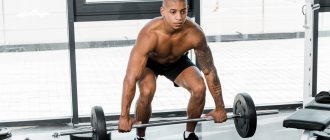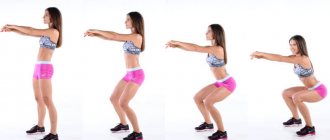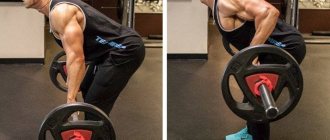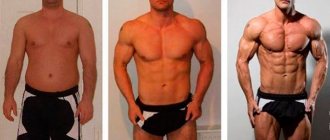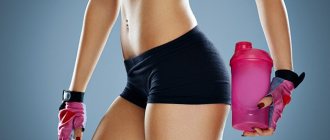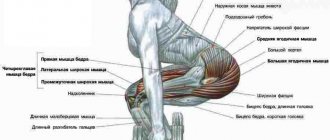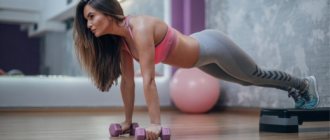Hello, dear friends. Every girl wants to have ideal body proportions. Most often, representatives of the fair sex are concerned with how to strengthen their abs, remove their sides, make their legs slender and their “butt” elastic. It is the toned buttocks that have long been considered a sign of sexuality and femininity. Therefore, today the “Me and Fitness” team will tell you how to properly pump up your butt at home and in the gym, and how long you need to do it for the results to appear.
Anatomy of the buttocks
The “butt area” is formed by several muscle groups - the gluteus maximus, medius and minimus, as well as the piriformis muscle. “In most cases, when girls come to the gym, they actively work only on the gluteus maximus muscle, thinking that it is this muscle that forms the volume,” says Alexey Bolyaev, trainer at the women’s fitness studio Women Secrets in Tsaritsyno. - But in fact, this volume can be increased only by training all four muscles of the buttocks. With an integrated approach, you will get the best results.”
Don't forget that the gluteus minimus and medius muscles also need active development. “They are responsible for movements in different planes in the hip joint,” adds Anastasia Yurkova, master trainer of the X-Fit group programs in Russia. “ Therefore, if you want a beautiful buttock shape, be sure to include the most diverse movements in your training program: leg abduction, rotation, hip extension and balance work with unstable surfaces.”
As you can see, squats alone are not enough to properly work out the buttocks. It is important to engage this area in a range of different movements.
Is it possible to pump up your buttocks in 2 weeks?
The growth of muscle volumes has a certain physiological pace. Of course, they are not the same for everyone. For example, one girl uses strength training to enlarge her buttocks by 3-4 cm in 2 months. And the second one takes from 6 to 12 months of training to achieve the same result.
Yes, with the help of exercises in 2 weeks it is possible to give the muscles more tone, but no more.
In general, their growth obeys its own biological laws and depends on a combination of many factors.
The first and most determining factor is genetics. In bodybuilding there is even the term “light muscle,” which implies very rapid growth of certain muscle groups from minimal physical activity.
If your “easy” muscle group is your glutes, you will actually bulk them up in a matter of weeks.
But this is rather an exception to the rule, and for many girls it is a much slower process.
The rate of muscle growth is also affected by:
- Level of physical fitness (the higher the level of fitness, the slower the growth)
- Age (the older, the more difficult)
- Use (or lack thereof) of sports nutritional supplements
- Dietary habits
- Recovery speed
- Presence of additional types of stress and much more
On average, during the first month of strength training, beginners increase the volume of their buttocks by 3-4 cm. Then the growth slows down and is approximately 1-2 cm per month.
Naturally, subject to all necessary conditions of training, nutrition and recovery.
As a result, the growth rate of the buttocks for girls with average genetics is 5-6 cm after 3-4 months of regular strength training. If you are aiming for more serious results, then this will take from 6 to 12 months of training.
Again, the numbers are quite average, since many factors influence the final result.
However, these are realistic rates of progress taken from practical experience in women's bodybuilding.
Why do you need to pump up your butt?
As we have already noted, training the buttocks area makes sense not only in order to confidently wear tight clothes. “Strong and functional buttocks are an opportunity to be as mobile as possible and be able to fully train the rest of the body,” says Alexey Bolyaev. - The buttocks are the “center of the body”, connecting the “top” and “bottom”. Therefore, the work of other muscle groups depends on their correct inclusion in the movement.”
Those who play sports should also pump up their butt. “We use our glutes in a lot of movements. When walking and running, in any bending and squatting, while skating, skiing, and playing sports,” notes Anastasia Yurkova.
Strong buttocks are also necessary for good posture. “The gluteal muscles are actively involved in shaping the position of the pelvis, and therefore posture,” comments Anastasia Yurkova. “If the gluteal muscles are not functional, you will most likely compensate for all movements during walking and bending by working the lumbar region of the back, overloading it.”
Finally, it’s worth pumping up your buttocks for the beauty of your thighs. “If the gluteal muscles are weak, the front surface of the thigh suffers greatly, an area of excessive tone, fluid accumulation, swelling and cellulite is formed,” sums up Anastasia Yurkova.
How to pump up your butt
Experts recommend approaching this issue comprehensively. “First, you need to restore muscle functionality,” says Anastasia Yurkova. — Functional exercises in different planes and movements with balance are suitable for this. If they are difficult, it is important to prepare the hip joints for work with a set of mobility exercises.”
Functional exercises will “wake up” the gluteal muscles and “teach” them how to properly engage in work. In particular, do not “shift” the load in exercises to other muscles: many perform squats by tensing the front surface of the thighs, rather than the gluteal muscles. “For muscle growth, I recommend adding strength exercises. Basic: lunges, squats, glute bridge, deadlifts. You can refine the silhouette with various swings, abduction of the hips to the sides, hyperextension,” advises Alexey Bolyaev.
It is also necessary to include muscle stretching exercises in this area in your training. “If you have functional buttocks, you can do cardio exercises: skating, running, walking uphill,” adds Anastasia Yurkova.
Try to include all of these exercises in your training program, wherever you work out: at home or in the gym.
You can train your gluteal muscles up to 4-5 times a week, alternating exercises and types of loads. We present two sets of exercises that will help you quickly pump up your butt.
What influences the result
The buttocks, like other muscle groups, grow subject to several factors:
- Sufficient physical activity
In order for muscles to increase, they need a push. Regular and intense training is a must for growth.
The last 3-5 reps of a set should be hard (with proper technique), otherwise you're just doing general conditioning and strengthening of the body.
Muscles will not grow from low loads.
- Required amount of protein in the diet and total calories
For growth, you need an excess of calories (+150-200 kcal to the daily norm) and protein so that you have something to build muscles from.
The recommended protein intake per day is 1.5-2 g per 1 kg of your body weight. That is, a girl weighing 50 kg needs 75-100 g of protein per day.
- High-quality restoration
Muscles grow not during, but after training, when the body recovers from stress.
Therefore, 7-8 hours of sleep, an adequate amount of exercise per week and a lack of stress should become your routine.
How long it takes to pump up your butt will depend on these three components.
If your workouts are half-hearted, you don’t follow the principles of proper nutrition and you recover poorly, then you won’t be able to achieve rounded shapes.
Pump up your butt: training at home
The author of the complex is Pamela Reif, a German trainer and fitness blogger . The workout includes compound and isolated bodyweight exercises to target the gluteal muscles. The program contains movements to work the gluteus maximus, medius, minimus and piriformis muscles.
How to conduct a lesson
- Start your workout with a simple warm-up. It will help prepare the body for stress and protect against possible injuries.
- Do the exercises consistently.
- Finish your workout with light stretching.
- Do this program 4-5 times a week.
To complete the complex you only need a mat.
"Pulse" lunges
Stand straight, feet shoulder-width apart. Place your palms together at chest level. Step your left foot back and, bending your knees, lower into a lunge. Using the muscles of your thighs, legs and buttocks and slightly extending your knees, lift yourself up slightly. Then lower yourself down again, bending your knees more. This is one repetition. Complete a maximum of these in 30 seconds . Rest for 10 seconds and repeat the same on the other leg.
Lunges with knee lift
Stand straight, feet shoulder-width apart. Place your palms together at chest level. Step your left foot back and, bending your knees, lower into a lunge. Shift your body weight to your right foot, lift your left leg in front of you and stretch your knee forward and up. Actively work the muscles of your hips, legs and abs. Then lower yourself back into a lunge, stepping your left foot back. This is one repetition. Complete a maximum of these repetitions in 30 seconds . Rest for 10 seconds and repeat the same on the other side.
Jump Squats
Stand straight, feet shoulder-width apart. Bend your knees, push your pelvis back and lower yourself into a squat, placing your palms together in front of your chest. Do not bend in the lower back, work the muscles of the buttocks, abs, thighs and legs. Return to an upright position. Push your feet off the floor and jump up. This is one repetition. Complete maximum repetitions in 30 seconds .
Squats with side steps
Stand straight, feet shoulder-width apart. Bend your knees, push your pelvis back and lower yourself into a squat, placing your palms together in front of your chest. From this position, straighten up, keeping your knees soft, and step to the left. Then lower yourself back into a squat. This is one repetition. Perform a maximum of these in 30 seconds , stepping right and left.
Sumo squats
Stand up straight, place your feet wider than your shoulders, and point your toes out to the sides. Bend your knees and lower yourself into a squat. Do not bend in the lower back, stretch the top of your head up, work the muscles of your abs, legs and hips. Smoothly straighten your knees and return to the starting position. This will amount to one repetition. Complete maximum repetitions in 30 seconds.
Squats with hip extension
Stand straight with your feet slightly wider than shoulder-width apart. Bend your knees, push your pelvis back and lower yourself into a squat, placing your palms together in front of your chest. While holding this position, try to slightly spread your knees and hips to the sides, as if you were stretching an expander with them. Then return them to their original position (slightly wider than shoulder width) and bring them a little closer to each other. This is one repetition, complete a maximum of these in 30 seconds. Keep your pelvis in one position all this time.
Swing your legs from the cat position
Get down on your knees, lean your body forward, lean on your straight arms. Maintain a neutral lower back position and work your abdominal muscles. Lift your left leg off the floor and extend its top, pointing your foot towards the ceiling. Then bend your left leg and lower it down, but do not touch the floor with your knee. This is one repetition, complete a maximum of these in 30 seconds . Then change the position of your legs and do the same in the other direction.
Diagonal leg swings from the cat position
Get down on your knees, lean your body forward, place your palms on the floor and lean on your straight arms. Maintain a neutral lower back position and work your abdominal muscles. Lift your left leg off the floor, take it a few centimeters to the left and extend its top, pointing the toe towards the ceiling. Then bend your left leg and lower it down, but do not touch the floor with your knee. This is one repetition, complete a maximum of these in 30 seconds . Then change the position of your legs and do the same in the other direction.
Swing your legs to the side and back
Get down on your knees, lean your body forward, place your palms on the floor and lean on your straight arms. Maintain a neutral lower back position and work your abdominal muscles. Lift your left leg off the floor (keep your knee bent), move it to the side (thigh parallel to the floor), then return to the starting position and immediately extend your leg back and up. This is one repetition, complete a maximum of these in 30 seconds . Then change the position of your legs and do the same in the other direction.
"Frog" kicks
Lie on your stomach, rest your forehead on your crossed palms. Bend your knees and lift your shins up. Actively work your buttocks and abs, do not strain your lower back. In this position, lift your left foot up, straightening your left knee as far as possible. Push off the floor with your hip bones and right knee. Then lower your left foot to the starting position and extend your right leg up. This is one repetition, complete a maximum of these in 30 seconds .
Advanced frog kicks
Lie on your stomach, rest your forehead on your crossed palms. Bend your knees and lift your shins up. Actively work your buttocks and abs, do not strain your lower back. In this position, lift both feet up, straightening your knees as much as possible. Push off the floor with your pelvic bones. This is one repetition, complete a maximum of these in 30 seconds .
Gluteal bridge in dynamics
Lie on your back, bend your knees, place your feet on the floor. Stretch your arms along your body, relax your neck and shoulders. Smoothly lift your pelvis above the floor, actively working the muscles of your legs, buttocks and abs. Then gently lower your pelvis down. This is one repetition, complete a maximum of these in 30 seconds .
Glute bridge with leg raise
Lie on your back, bend your knees, place your feet on the floor. Stretch your arms along your body, relax your neck and shoulders. Raise your left leg off the floor (keep it parallel to the mat). Smoothly lift your pelvis off the floor, actively working the muscles of your hips, buttocks and abs. Then gently lower your pelvis down. Keep your left leg suspended. This is one repetition, complete a maximum of these in 30 seconds . Then do the same in the other direction.
Gluteal bridge in dynamics
Lie on your back, bend your knees, place your feet on the floor. Stretch your arms along your body, relax your neck and shoulders. Smoothly lift your pelvis above the floor, actively working the muscles of your legs, buttocks and abs. Then gently lower your pelvis down. This is one repetition, complete a maximum of these in 30 seconds .
Glute bridge with alternating leg raises
Lie on your back, bend your knees, place your feet on the floor. Stretch your arms along your body, relax your neck and shoulders. Smoothly lift your pelvis off the floor, actively working the muscles of your hips, buttocks and abs. At the top of the movement, extend your left leg forward for 1-2 seconds, then place your left leg on the floor and smoothly lower your pelvis down. This is one repetition, complete a maximum of these in 30 seconds . Then do the same in the other direction.
Gluteal Bridge
Lie on your back, bend your knees, place your feet on the floor. Stretch your arms along your body, relax your neck and shoulders. Smoothly lift your pelvis above the floor, actively working the muscles of your legs, buttocks and abs. Lock in this position for 30 seconds. Then gently lower your pelvis down.
What you need to progress your glutes
As with any muscle in the body, regardless of gender, all the necessary conditions must be created for the growth of the buttocks. These conditions are quite simple, but they require discipline, patience and motivation, because without a clear goal and desire, at a certain stage of your path there is a risk of giving up everything.
And also, let’s look at one nuance: toning and “pumping up” muscles are different things and the ways to achieve these goals will also be different. Tone is the strengthening of muscles, increasing their density and elasticity without changing size, and the colloquial expression “pump up” implies an increase in muscle volume, in other words, making the buttocks larger. It is for these purposes that the following recommendations are aimed.
Workout
Briefly about muscle growth in simple language: in order for muscles to grow, they need to be provided with a high load, which literally causes microtrauma to the muscle fibers. These microscopic tears during intense training allow new cells to form in their place, thereby expanding and enlarging the muscle structure. But new fibers are formed only under the condition of proper nutrition, which will be described further.
Therefore, to make your buttocks bigger and stronger, you need to resort to strength training with weights: machines and free weights. Let me clarify that muscles will not develop for long with the help of exercises with your own or too light weight. For further development, when the muscles become not enough, you will need to increase the working weight.
The number of workouts should not exceed two times a week. It is advisable not to load the muscles with more than four exercises per workout. It is best to do a three-day program, two days of which will work your legs and buttocks. In one workout, for example, the quadriceps and buttocks should be loaded, and after another workout, the hamstrings and buttocks should be loaded. This way, the leg muscles will not be overloaded, and the buttocks will work every time. The intermediate workout will not involve the lower body, which will ensure proper rest.
Nutrition
Nutrition in this matter is not in last place; it can be put on the same level of importance as training. One without the other will not bring any results. Therefore, in order to fill those micro-tears from strength training and enlarge the buttocks, you need to:
- Provide sufficient energy for training in the form of complex carbohydrates: cereals, grains, vegetables. To grow new fibers, the body requires at least three grams of net carbohydrates for every kilogram of weight. That is, with a weight of 50 kg, the need for pure carbohydrate will be 150 grams. To check how much nutrients you're getting, you need to keep a food diary and control your portions by counting your food intake.
- In the same way, it is necessary to regulate the amount of protein consumed from meat and seafood, which forms new cells, namely: at least 2 grams per kilogram of weight.
- You also cannot do without polyunsaturated fatty acids from vegetable oils, fish, nuts, the need for which is 1 gram per kilogram of weight.
Read more about the principles of PP →
Rest and recovery
This is an important component of progress in training; without rest, the athlete will stand in one place, since tired and overtrained muscles are not able to change in principle. The body will not spend the deficit of its own strength on building new muscle fibers; on the contrary, it will destroy them. Therefore, train at least every other day. Get at least eight hours of sleep.
Pump up your butt: training in the gym
This complex is suitable for those who have been going to the gym relatively recently. As the body adapts, the load can be increased: add the weight of the weights or the number of laps.
How to build a lesson
- Do some cardio before starting your workout.
- Build your workout according to the circular principle: perform the exercises sequentially for 20 repetitions without pauses between them. After completing the circuit (doing all 5 exercises), rest for 1 minute and start all over again. Do 3-5 laps per workout.
- Finish your workout with light stretching.
- Do this program 3-4 times a week.
To perform the complex, you will need a mat, a barbell and dumbbells with your working weight, and a block exercise machine.
Dumbbell Squats
32-kuzmich2
Place your feet slightly wider than your shoulders, point your toes to the sides. Hold the dumbbell with both hands and lower it just below groin level. Bend your knees and slowly lower yourself into a squat. Work the muscles of your thighs, buttocks, abs, and back. Then straighten smoothly, returning to the starting position, and repeat. Perform 20 repetitions of the exercise.
Deadlift
11 deadlift
Stand straight, feet shoulder-width apart. Grasp the barbell with an overhand grip. Stretch up with the top of your head, work the muscles of your abs, back, legs and arms. Bend your knees, move your pelvis back, slightly lean your body forward, and slide the bar down your legs. Maintain a natural arch in your lower back. Then, straightening your knees, return to the starting position and repeat. Perform 20 repetitions of the exercise.
Cross lunges with dumbbells
34-kuzmich4
Stand straight, feet shoulder-width apart. Take dumbbells in your hands. Step your left foot back and to the right, moving your left foot as far diagonally behind your right as possible. Lower into a lunge, bending your knees. Then smoothly straighten up, return to the starting position and step back and to the left with your right foot. With your feet in the desired position, bend your knees. Return to the starting position for one repetition. Perform 20 such repetitions.
Squats with a pulley machine
Stand facing the pulley machine. Attach the handle to the lower block and grasp it with both palms. Keep your arms straight. Bend your knees and keep the cable taut, lower into a squat. Then smoothly straighten your knees and return to the starting position. This will amount to one repetition, do 20 of these.
